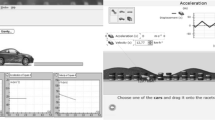Abstract
We examine the conceptual development resulting from an instructional experiment with an interactive learning environment in geometrical optics for introductory high school physics. How did teaching-learning processes come to change the ways in which students depicted various everyday optical situations in paper and pencil graphical representations? We view conceptual development as a process resulting in part from increasingly aligning one's practices to a target community by means of participating in a community of practice that uses the target concepts. For formal science learning, this participation requires changes in concepts, epistemological attitude, and in the development and use of representational tools, including diagrams and technical language, as a means of communication. Results of our instructional experiment indicated that students went through major conceptual developments as reflected in the diagrams they constructed and supported by other representational tools and as judged in terms of several perspectives: in identifying the formation of shadows and images, in recognizing the eye as a participating factpr in the optical system, and in changing the types of justifications they provided in their optical reasoning from presuppositional to causal.
Similar content being viewed by others
References
Anderson, C. W., and Smith, E. L. (1984). Children's preconceptions and content-area textbooks. In Duffy, G. G., Roehler, L. R., and Mason, J. (Eds.),Comprehension Instruction: Perspectives and Suggestions, New York: Longman, pp. 187–201.
Clement, J. (1982). Students' preconceptions in introductory mechanics.American Journal of Physics 50: 66–71.
DiSessa, A. (1982). Unlearning Aristotelian physics: A study of knowledge-based learning.Cognitive Science 6: 37–75.
Driver, R., Guesne, E., and Tiberghien, A. (Eds.) (1985).Children's Ideas in Science, Open University Press, Philadelphia.
Goldberg, F. M., and McDermott, L. C. (1986). Student difficulties in understanding image formation by a plane mirror.The Physics Teacher 24: 472–480.
Goldberg, F. M., and McDermott, L. C. (1987). An investigation of student understanding of the real image formed by a conerging lens or concave mirror.American Journal of Physics 55: 108–119.
Goodwin, C., and Heritage, J. (1990). Conversation analysis.Annual Review of Anthropology 19: 283–307.
Guesne, E. (1985). Light. In Driver, R., Guesne, E., and Tiberghien, A. (Eds.),Children's Ideas in Science, Open University Press, Milton Keynes, pp. 10–32.
Hanson, N. R. (1958).Patterns of Discovery, Cambridge University Press, Cambridge.
Hawkins, J., and Pea, R. D. (1987). Tools for bridging the cultures of everyday and scientific thinking.Journal for Research in Science Teaching 24: 291–307.
Heritage, J. (1984).Garfinkel and Ethnomethodology, Polity Press, Cambridge, England.
Hewson, P. W. (1981). A conceptual change approach to learning science.European Journal of Science Education 3(4): 383–396.
Hewson, P. W., and Hewson, M. G. A. (1984). The role of conceptual conflict in conceptual change and the design of science instruction.Instructional Science 13: 1–13.
Jul, S. (1991). Dynagrams: The Software. IRL Technical Report, Institute for Research on Learning, Palo Alto, California.
Jung, W. (1981). Conceptual frameworks in elementary optics. InProceedings of the International Workshop on Problems Concerning Students' Representations of Physics and Chemistry Knowledge, Ludwigsburg, West Germany.
Larkin, J. L., and Simon, H. A. (1987). Why a diagram is (sometimes) worth ten thousand words.Cognitive Science 11: 65–100.
Lave, J., and Wenger, E. (1991).Situated Learning: Legitimate Peripheral Participation. Cambridge University Press, New York.
Lemke, J. L. (1990).Talking Science: Language, Learning, and Values, Ablex, Norwood, New Jersey.
Miller, A. I. (1986).Imagery in Scientific Thought, MIT Press, Cambridge, Massachusetts.
Pea, R. D. (1992). Augmenting the discourse of learning with computer-based learning environments. In de Corte, E., Linn, M., and Verschaffel, L. (Eds.),Computer-Based Learning Environments and Problem-Solving (NATO Series, subseries F: Computer and System Sciences), Springer-Verlag, New York, pp. 313–343.
Pea, R. D. (1993). Learning scientific concepts through material and social activities: Conversational analysis meets conceptual change.Educational Psychologist 28(3): 265–277.
Pea, R. D. (1994). Seeing what we build together: Distributed multimedia learning environments for transformative communications.Journal of the Learning Sciences 3(3): 283–298.
Pea, R. D., Sipusic, M., and Allen, S. (1995). Seeing the light on optics: Classroom-based research and development of a learning environment for conceptual change. In Strauss, S. (Ed.),Development and Learning Environments: Seventh Annual Workshop on Human Development, Ablex, Norwood, New Jersey (in press).
Posner, G. J., Strike, K. A., Hewson, P. W., and Gertzog, W. A. (1982). Accommodation of a scientific conception: Toward a theory of conceptual change.Science Education 66(2): 211–227.
Schegloff, E. A. (1991). Conversation analysis and socially shared cognition. In Resnick, L., Levine, J., and Behrend, S. D. (Eds.),Socially Shared Cognition, APA Press, Washington, DC, pp. 150–171.
Schegloff, E. A., and Sacks, H. (1973). Opening up closings.Semiotica 7: 289–327.
Toulmin, S. E. (1953).The philosophy of Science: An Introduction, Hutchinson & Co., London.
Author information
Authors and Affiliations
Rights and permissions
About this article
Cite this article
Reiner, M., Pea, R.D. & Shulman, D.J. Impact of simulator-based instruction on diagramming in geometrical optics by introductory physics students. J Sci Educ Technol 4, 199–226 (1995). https://doi.org/10.1007/BF02211837
Issue Date:
DOI: https://doi.org/10.1007/BF02211837




